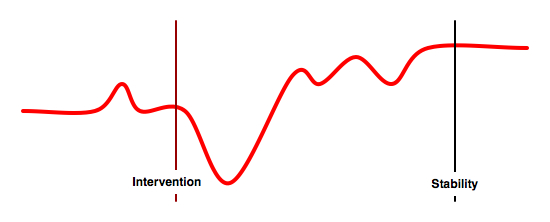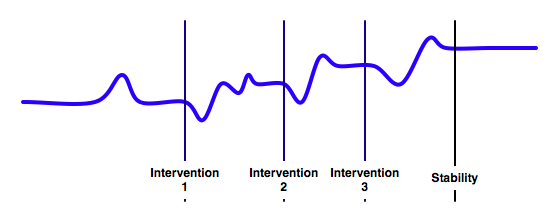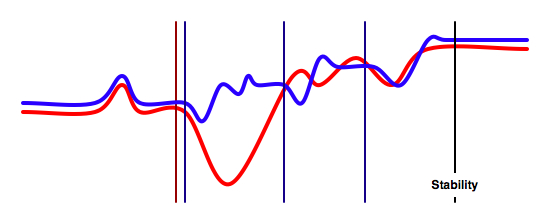Where do the problems lie in getting good learning experiences? We need them, as it’s becoming increasingly important to get the important skills really nailed, not just ‘addressed’. It’s not about dumping knowledge on someone, or the other myriad ways learning can be badly designed. It’s about making learning experiences that really deliver. So, where does the process of creating a learning experience go wrong?
There’s been a intriguing debate over at Aaron (@mrch0mp3rs) Silver’s blog about where the responsibility lies between clients and vendors for knowledge to ensure a productive relationship. One of the issues raised (who, me?) is understanding design, but it’s clearly more than that, and the debate has raged.
Then, a post in ITFORUM asked about how to redo instructor training for a group where the instructors are SMEs, not trainers, and identified barriers around curriculum, time, etc. What crystallized for me is that it’s not a particular flaw or issue, but it’s a system that can have multiple flaws or multiple points of breakdown.
 The point is, we have to quit looking at it as design, development, etc; and view it not just as a process, but as a system. A system with lots of inputs, processes, and places to go wrong. I tried to capture a stereotypical system in this picture, with lots of caveats: clients or vendors may be internal or external, there may be more than one talent, etc, it really is a simplified stereotype, with all the negative connotations that entails.
The point is, we have to quit looking at it as design, development, etc; and view it not just as a process, but as a system. A system with lots of inputs, processes, and places to go wrong. I tried to capture a stereotypical system in this picture, with lots of caveats: clients or vendors may be internal or external, there may be more than one talent, etc, it really is a simplified stereotype, with all the negative connotations that entails.
Note that there are many places for the system to break even in this simplified representation. How do you get alignment between all the elements? I think you need a meta-level, learning experience creation system design. That is, you need to look at the system with a view towards optimizing it as a system, not as a process.
I realize that’s one of the things I do (working with organizations to improve their templates, processes, content models, learning systems, etc), trying to tie these together into a working coherent whole. And while I’m talking formal learning here, by and large, I believe it holds true for performance support and informal learning environments as well, the whole performance ecosystem. And that’s the way you’ve got to look at it, systemically, to see what needs to be augmented to be producing not content, not dry and dull learning, not well-produced but ineffective experiences, but the real deal: efficient, effective, and engaging learning experiences. Learning, done right, isn’t a ‘spray and pray’ situation, but a carefully designed intervention that facilitates learning. And to get that design, you need to address the overall system that creates that experience.
The client has to ‘get’ that they need good learning outcomes, the vendor has to know what that means. The designer/SME relationship has to ensure that the real outcomes emerge. The designer has to understand what will achieve these outcomes. The ‘talent’ (read graphic design, audio, video, etc) needs to align with the learning outcomes, and appropriate practices, the developer(s) need to use the right tools, and so on. There are lots of ways it can go wrong, in lack of understanding, in mis-communication, in the wrong tools, etc. Only by looking at it all holistically can you look at the flows, the inputs, the processes, and optimize forward while backtracking from flaws.
So, look at your system. Diagnose it, remedy it, tune it, and turn it into a real learning experience creation system. Face it, if you’re not creating a real solution, you’re really wasting your time (and money!).


 By having smaller introductions that break up the intervention, you decrease the negative effects. The point is to take small steps that make improvements instead of a monolithic change.
By having smaller introductions that break up the intervention, you decrease the negative effects. The point is to take small steps that make improvements instead of a monolithic change. The goal is to maximize improvements while minimizing disruption, and doing so in ways that capitalize on previous efforts and existing infrastructure. To do this really requires understanding how the different components relate: how content models support mobile, how performance support articulates with formal learning and social media, and more. And, of course, understanding the nuances of the underpinning elements and how they are optimized.
The goal is to maximize improvements while minimizing disruption, and doing so in ways that capitalize on previous efforts and existing infrastructure. To do this really requires understanding how the different components relate: how content models support mobile, how performance support articulates with formal learning and social media, and more. And, of course, understanding the nuances of the underpinning elements and how they are optimized.